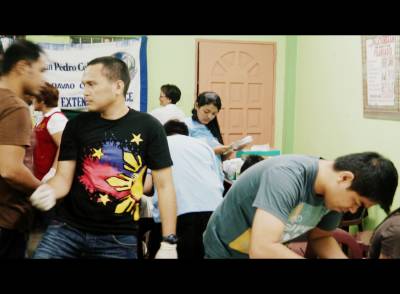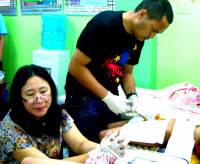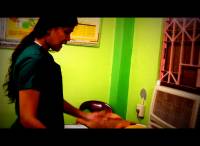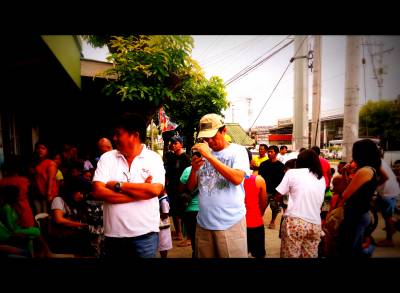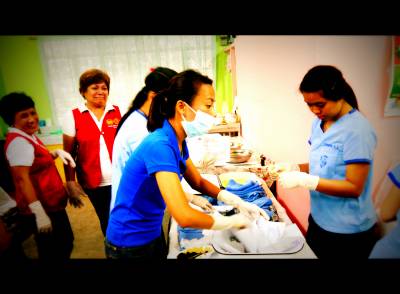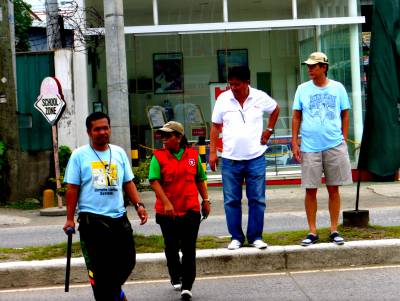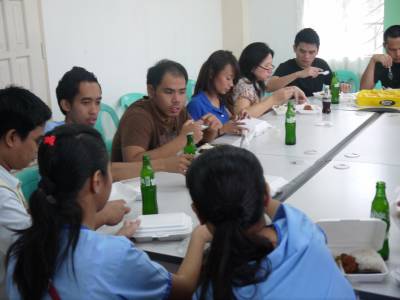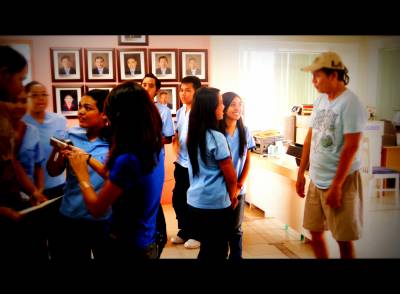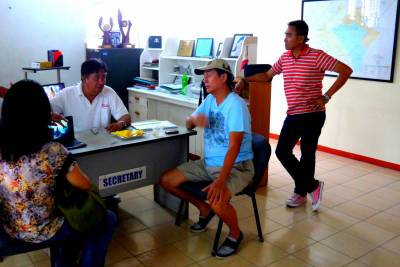12.03 PM Operation Tuli 2012! | |
The
"Operation Tuli” was recently conducted in this barangay last April 29, 2012
through the initiative of Kagawad Erico R. Talili the Chairman on the Committee
on Health and fully supported by Punong Barangay Ralph O. Abella together with
all the members of the Council. On the forefront of the circumcision were two teams of medical practitioners. First the Group of Dr. Julinda Acosta from the City Health Office-Sasa District composed of nurses Rhea Riz Amora, Eldy Sombilon, Araceli Batacan....and others.. The second group from Davao Medical School Foundation Inc. was headed by Dr. Narisma along with Post Graduate Interns Ian Abundo, Maya Talampas...and others... Betadine Davao donated some six (6) bottles of betadine and was received by Kagawad Eric Talili and brgy. midwife Emily Villagonzalo RN. Some award winning facial expressions were captured in a camera during the height of the activity. Around 70 children were circumcised during the half-day operation and as Kagawad Delfin Compoc quickly quipped, "Hurot-hurot na gyud and supot sa Hizon." Sec RED History of CircumcisionIntroduction The practice of male genital mutilation is far older than recorded history. Certainly, it is far older than the Biblical account of Abraham (Genesis 17). It seems to have originated in eastern Africa long before this time.8 21 Many theories have been advanced to explain the origin of genital mutilation. One theory postulates that circumcision began as a way of "purifying" individuals and society by reducing sexuality and sexual pleasure. Human sexuality was seen as dirty or impure in some societies; hence cutting off the pleasure-producing parts was the obvious way to "purify" someone. It is now known that the male foreskin, or prepuce, is the principal location of erogenous sensation in the human male (seeAnatomy.) Removal of the prepuce substantially reduces erogenous sensation.14,19 Therefore (in the appropriate cultural context), circumcision is revealed as a sacrifice of "sinful" human enjoyment (in this earthly life), for the sake of holiness in the afterlife.14 The Jews adopted circumcision as a religious ritual10,13,16,20 and preserved this prehistoric practice into modern times.11,20 The circumcision of Abraham removed only the very tip that extended beyond the glans penis.11,20,26,31 Moses and his sons were not circumcised. (Exodus 4:25) Although Moses apparently prohibited circumcision during the 40 years in the wilderness,20,21,24(Joshua 5:5) Joshua reinstituted circumcision at Gilgal after the death of Moses.20,21,24 (Joshua 5:2-10) It is interesting to note that after the Israelites were circumcised, they immediately became soldiers in Joshua's army for the conquest of Palestine. (Joshua 6:1-3) In contrast to the Jews, the Greeks and the Romans placed a high value on the prepuce..3 34 The Romans passed several laws to protect the prepuce by prohibiting circumcision.3 34 The laws were applied to everyone and were not directed against the Jews. 3 Much later in the Hellenic period, about 140 C.E., the Jewish authorities modified circumcision procedure to make it impossible for a Jew to appear to be an uncircumcised Greek.10,11,20,30 A radical new procedure called peri'ah was introduced by the priests and rabbis. In this procedure the foreskin was stripped away from the glans, with which it is fused in the infant (See Normal.) In a painful procedure known today as a synechotomy, more foreskin was removed than before and the injury was correspondingly greater. With the introduction of peri'ah, the glans could not easily be recovered, and so no Jewish male would easily be able to appear as an uncircumcised Greek.10,11,20,31 This radical modified procedure eventually was adopted by the medical profession and is the circumcision operation used today. Although Judaism mandated circumcision, not all Jews wanted to be circumcised. Several methods of foreskin restoration were devised and practiced.101125 It may have been at this time that the Pondus Judaeus (also known as Judaeum Pondum), a bronze weight worn by Jews on the residual foreskin to stretch it back into a foreskin,10,11,25 gained popularity amongst Jewish males. This lessened the ugly appearance of the bare exposed circumcised penis.10 25 This restorative procedure was known by the Greek word epispasm,10 or "rolling inward." The third stage of ritual circumcision, the Messisa or Metzitzah, was not introduced until the Talmudic period (500-625 C.E).11,20,25 In Metzitzah, the mohel (ritual circumciser) sucks blood from the penis of the circumcised infant with his mouth.34 This procedure has been responsible for the death of many Jewish babies due to infection.16 In modern times, a glass tube is sometimes used instead.19 The Reform movement within Judaism considered circumcision to be a cruel practice.20 The Reform movement at Frankfort declared in 1843 that circumcision was not necessary.20,24 Theodor Hertzl, the founder of Zionism, refused to have his son circumcised. The Christians took a strong stand against circumcision in the first century. Christians rejected circumcision at the Council at Jerusalem.16 (Acts 15) St. Paul, the apostle to the gentiles, taught parents that they should not circumcise their children. (Acts 21:25) In a reference to the old practices of genital mutilation, St. Paul warned Titus to beware of the "circumcision group." (Titus 1:10-16) The modern use of Hebrew circumcision as a medicalized practice dates from about 1865 in England and about 1870 in the US.12The procedure accepted for medical use essentially was the Jewish peri'ah. Moscucci reports that circumcision was imposed in an attempt to prevent masturbation.18 Gollaher further describes the history of medicalized circumcision.13 No scientific studies were carried out to determine the efficacy and safety of circumcision prior to its introduction into medical practice,13 nor were any studies conducted to determine the social effects of imposing genital alteration surgery on a large portion of the population. South Koreans started to circumcise children during the American trusteeship following World War II. The American cultural practice of circumcision became nearly universal in South Korea after the Korean War of 1950-52.27 In 1949, Gairdner wrote that circumcision was medically unnecessary and non-beneficial, and contraindicated because of complications and deaths.5 The British National Health Service (NHS) deleted non-therapeutic neonatal circumcision from the schedule of covered procedures in 1950. The incidence of neonatal circumcision in the United Kingdom declined sharply to a very low level after publication of this article after the procedure was delisted by the NHS. America waited another 20 years before addressing the problem of non-therapeutic circumcision. The Journal of the American Medical Association published an influential landmark article by Dr. E. Noel Preston, Captain, MC, USAF.6 Dr. Preston established that there is no therapeutic or prophylactic benefit to circumcision. He also cited "undesirable psychologic, sexual, and medico-legal difficulties."6 Influenced by Preston, the American Academy of Pediatrics (AAP), in 1971, issued a statement that "[t]here are no valid medical indications for circumcision in the neonatal period."12 This marked the beginning of the end of America's infatuation with male circumcision. The incidence of male neonatal circumcision in the U.S. peaked in 1971 and began a slow decline that continues to the present day. Recent HistoryThe AAP convened an "ad hoc Task Force" under the chair of Hugh C. Thompson, M.D., to review the issue of circumcision in 1975. The 1975 Task Force reaffirmed the 1971 AAP statement.11 The Canadian Paediatric Society (CPS) also took a position in 1975 that circumcision is medically unnecessary. The matter rested there until 1985, when retrospective data collected from U.S. Army medical records by Thomas Wiswell, M.D. seemed to show a somewhat higher rate of urinary tract infection (UTI) in non-circumcised boys. Careful examination of Wiswell's methods and data revealed many methodological flaws which rendered his conclusions questionable and unreliable. This created new controversy about the value of neonatal circumcision. The Canadian Paediatric Society examined Wiswell's data in 1989 and found it to be "insufficiently compelling" to cause it to change its 1975 policy statement, which is against circumcision. The National Organization of Circumcision Information Resource Centers (NOCIRC) was formed in 1986. The mandate of NOCIRC is to provide accurate information regarding male circumcision, to promote children's rights, and to shed light on the medical mistakes of the past. Professor George C. Denniston, M.D., M.P.H., founded Doctors Opposing Circumcision (DOC) in 1995 to promote the health advantages of genital integrity within the medical community. The Circumcision Information and Resource Pages (CIRP) were created in 1995 to provide a source of accurate information about circumcision on the World Wide Web. The development of new information in the medical literature since 1975 caused the AAP to revisit the matter of circumcision in 1989. A new Task Force under the chair of Edgar J. Schoen, M.D., examined new data about neonatal pain, behavior changes, and loss of sexual sensitivity secondary to neonatal circumcision. New data also conclusively established the role of the human papillomavirus (HPV) in the pathogenesis of genital cancers. This removed any lingering belief that the prepuce somehow caused cancer. The Canadian Paediatric Society revisited the matter of neonatal circumcision in 1996. A new evidence-based policy statement was issued that strengthened its 1975 recommendation, stating that circumcision is medically unnecessary. The CPS recommended: "Circumcision should not be routinely performed." The incidence of neonatal circumcision in the US has continued to decline, and stood at only 60% in 1996. In the same year, the Australian College of Paediatrics (ACP) reported that the incidence of neonatal circumcision in Australia has continued its decline to 10%. The ACP termed circumcision traumatic, a possible violation of human rights, and called for parents to be provided with full and complete information about circumcision before making a decision. John R. Taylor and colleagues published a landmark article in 1996 that described original research into the anatomy and histology of the foreskin. The research showed that the foreskin is highly innervated tissue with the characteristics of a sensory organ designed to provide erogenous sensation.19 The American Academy of Pediatrics (AAP) and the American College of Obstetricians and Gynecologists (ACOG), in a joint statement, reclassified neonatal circumcision from "routine" to "elective" in 1997.23 The change in policy was announced the year after the publication of Taylor's important article that describes in detail the injury inherent in every circumcision. This action removes any suggestion that circumcision is beneficial or that it is recommended by medical authorities. It may also be an attempt to shift legal liability for the injury that is inherent in every child circumcision from the doctor to the parents. Persistent criticism of the obvious flaws of the supplemental 1989 Report of the Task Force on Circumcision has caused the AAP to distance itself from its own report. The AAP has removed its policy statement from its website. The AAP convened a new Task Force under the chair of Carole Marie Lannon, MD, in 1997 to develop a new evidence-based policy statement which was released in March 1999. After fully reviewing the medical evidence, the Task Force concluded that routine neonatal circumcision cannot be recommended because of lack of any proved benefit. It said that the benefits are "potential" (i.e. they are unproven). The Council on Scientific Affairs of the American Medical Association issued a policy report in December 1999 that re-classified neonatal circumcision as a "non-therapeutic" procedure.33 This may have a medico-legal impact. The ratio of boys circumcised to boys preserved intact continues to decline in America. In 2001, it had further declined to a ratio of 55 percent circumcised, while the percentage of boys preserved intact had risen to 45 percent.40 | |
|
| |
Tuesday, 2025.12.09, 3.52 PM
Welcome Guest
Welcome Guest
Main » 2012 April 29 » Operation Tuli 2012!
